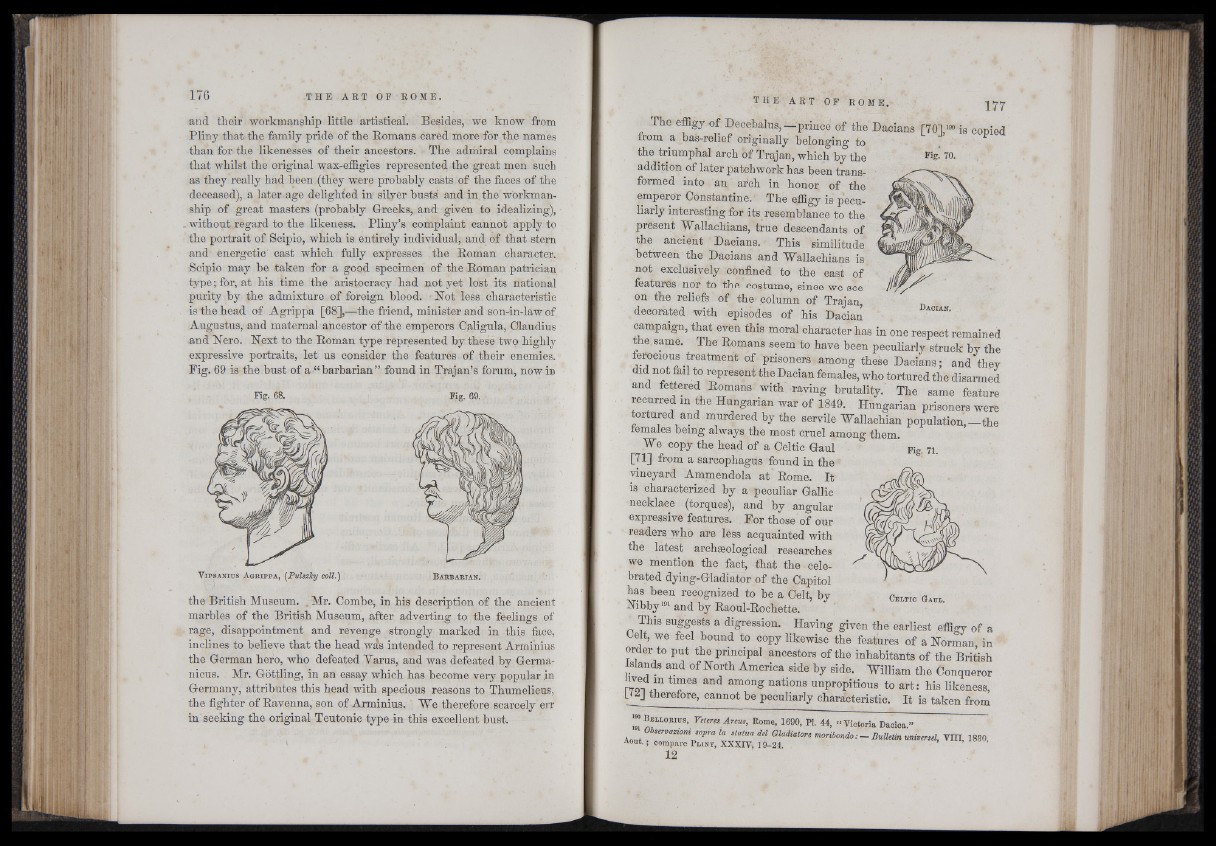
and their workmanship little artistical. Besides, we know from
Pliny that the family pride of the Romans cared more for the names
than for the likenesses of their ancestors. The admiral complains
that whilst the original wax-effigies represented the great men such
as they really had been (they were probably casts of the faces of the
deceased), a later age delighted in' silyer busts' and in the workmanship
of great masters (probably Greeks, and given to idealizing),
without regard to the likeness. Pliny’s complaint cannot apply to
the portrait of Scipio, which is entirely individual, and of that stern
and energetic cast which fully expresses the Roman character.
Scipio may be taken for a good specimen of the Roman patrician
type; for, at his time the aristocracy had not yet lost its national
purity by the admixture of foreign blood. Not less. characteristic
is the head of Agrippa [68],—the friend, minister and son-in-law of
Augustus, and maternal ancestor of the emperors Caligula, Claudius
and Nero. Next to the Roman type represented by these two highly
expressive portraits, let us consider the features of their enemies.
Pig. 69 is the bust of a “barbarian” found in Trajan’s forum, nowiD
Fig. 68. Fig. 69.
V ip sa n it js A g r i p p a , (Pulszky coll.) B a r b a r ia n .
the British Museum. , Mr. Combe, in his description of the ancient
marbles of the British Museum, after adverting to the feelings of
rage, disappointment and revenge strongly marked in this face,
inclines to believe that the head was intended to represent Arminius
the German hero, who defeated Varus, and was defeated by Germa-
nicus. Mr. Gottling, in an essay which has become very popular in
Germany, attributes this head with specious reasons to Thumelicus,
the fighter of Ravenna, son of Arminius. ; We therefore scarcely ear
in seeking the original Teutonic type in this excellent bust.
The effigy of Decebalus, —(prince of the Dacians [70],190 is copied
from a bas-relief originally belonging to
the triumphal arch of Trajan, which by the Fis' 70-
addition of later patchwork has been transformed
into an arch in honor of the
emperor Constantine.r The effigy is peculiarly
interesting for its resemblance to the
present Wallachians, true descendants of
the ancient Dacians. This similitude
between the Dacians and Wallachians is
not exclusively confined to the cast of
features nor to the costume, since we see
on the reliefs of the'column of Trajan,
decorated with episodes of his Dacian fjf"'
campaign, that even this moral character has in one respect remained
he same. The Romans seem to have been peculiarly struck by the
ferocious treatment of prisoners among these Dacians; and they
did not fail to represent the Dacian females, who tortured the disarmed
and fettered Romans with raving brutality.' The same feature
recurred in the Hungarian war of 1849. Hungarian prisoners were
tortured and murdered by the servile Wallachian population,-the
iemales being always the most cruel among them.
We copy the head of a Celtic Gaul
[71] from a sarcophagus found in the
vineyard Ammendola at Rome. It
is characterized by a peculiar Gallic
necklace (torques), and by angular
expressive features. Bor those of our
readers who are less acquainted with
the latest archaeological researches
we mention the fact, that the celebrated
dying-Gladiator of the Capitol
has been recognized to be a Celt, by
Nibby191 and by Raoul-Rochette.
This suggests a digression. Having given the earliest effigy of a
Celt, we feel bound to copy likewise the features of a Norman, in
order to put the principal ancestors of the inhabitants of the British
Islands and of North America side by side. William the Conqueror
2 ? tT 6S and am°ng nations »»Propitious to art: his likeness,
L J therefore, cannot be peculiarly characteristic. It is taken from
B e llob ic s, Vetera Arcus, Roma, 1690, PI. 44, “ Victoria Dacica.”
Observaziom soprala statu, del Gladiators moriboado.— Bulletin universel, VHI, 1830
Aout.; compare P u n y , XXXIV, 19-24
12
Fig. 71.
C e l t ic G a u l .